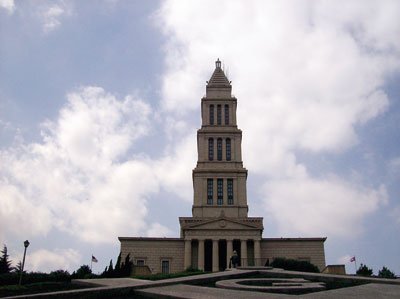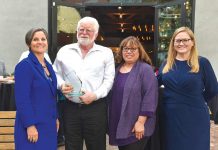Last month the City of Gilroy dedicated its new police
headquarters. Almost as controversial as the building itself was
the fact that officials of the local
Masonic organization were invited to participate in the
ceremony. A critical letter to the editor of The Dispatch caused me
to explore this venerable group during a recent visit to
Washington, D.C.
Last month the City of Gilroy dedicated its new police headquarters. Almost as controversial as the building itself was the fact that officials of the local Masonic organization were invited to participate in the ceremony. A critical letter to the editor of The Dispatch caused me to explore this venerable group during a recent visit to Washington, D.C.
Just south of our nation’s capital, a mile from the Potomac River, in the historic city of Alexandria, Va., is the George Washington Masonic National Memorial.
This unique building, rising 333 feet above Shooter’s Hill, is modeled after an ancient lighthouse in Alexandria, Egypt. The building was dedicated in 1932 as an expression of the Masonic fraternity’s faith in the principles of liberty and orderly government “portrayed in the character and life of Washington.”
The building was funded by contributions of Masons from across the country. Inside are a number of interesting rooms and exhibits:
– Photos of the labor-intensive construction,
– a museum of personal items of Washington,
– a 25,000 volume library of Masonic and related works,
– an 18-by-46 foot mural of Washington laying the Capitol’s cornerstone,
– a replica of the lodge room where George Washington served as Worshipful Master,
– an assembly hall with a 17th century Persian rug measuring 30 x 50 feet, and
– an observation deck at the tower’s top affording a great view of Washington, D.C.
Freemasonry, founded in London in 1717, is the world’s largest “secret society” with a reported 6 million members today. The term “Freemasonry” has an interesting genesis. In the Middle Ages the masons who constructed magnificent cathedrals and palaces of stone were much admired. Because their skills were in great demand, they could travel freely between countries and were called “freemasons.”
When construction techniques began to change In the 17th century, the number of masons began to decline, so their guild lodges began to admit prominent men who were not really stonemasons but had interest in Greek and Roman architecture and were seeking for a “greater truth that they believed the moral and ethical rigors of Freemasonry provided.”
They became known as “accepted masons.”
By the end of the century these accepted masons became the majority, and their lodges began to emphasize moral philosophy rather than techniques of construction.
Although the moral philosophy of Freemasonry is founded upon religious principles, it is not a religion. Members must, however, profess a belief in God and be of good moral character.
Over the centuries controversy has arisen concerning this group. The A&E cable network has shown a documentary with detractors testifying that Masons practice ceremonies contrary to Christian teachings, threaten death to those who violate their oaths and commit crimes to protect each other. In 1987 the Southern Baptist Convention debated the compatibility of being a Christian and Mason; they concluded it was a personal decision.
Masons, on the other hand, point out that some of the most respected men in U.S. history have belonged to the order: John Wayne, Mark Twain, Henry Ford, Neil Armstrong, as well as many signers of the Declaration of Independence and the U.S. Constitution.
Fifteen presidents have been Masons, most recently Harry Truman and Gerald Ford.
In addition, the group spends more than $2 million per day on charitable work, through the Shriners, sponsoring a network of hospitals, burn centers, eye foundations, and medical research facilities; more than 123,000 patients were treated for free in 2005.
There are Masonic lodges in both Gilroy and Morgan Hill and more than 100,000 members in California. To learn more about the Free and Accepted Masons call 1-888-597-9100 or check the internet at www.freemason.org.













